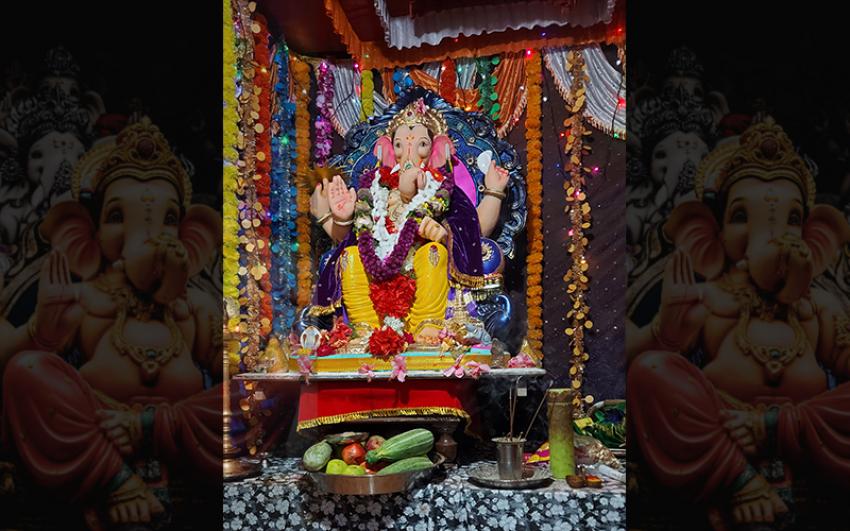NITN | @notintownlive | 31 Oct 2023, 02:26 am
 Ganesh Festival
Ganesh Festival
Image credit: Maharashtra Tourism/Facebook
Ratnagiri in Maharashtra, better known for its Alphonso (Hapus) mangos, is a quaint town which can be the gateway to scenic and historical attractions, discovers Uttara Gangopadhyay, while attending the International Ganesh Festival organised by Maharashtra Tourism.
Day one: The journey begins
 Image credit: Varad Parulekar/Unsplash
Image credit: Varad Parulekar/Unsplash
The Konkani countryside unfurled itself like a velvety green tapestry as the bus sped along the highway. Sometime back, we had boarded the luxury bus from the new airport – Manohar International Airport – in north Goa and were heading towards Ratnagiri in Maharashtra.
But with the rain lashing hard against the glass panes, it was difficult to catch the details.
Occasionally, there would be breaks in the green to reveal a cluster of rural homes, a bus stop with a few people, a knot of shops, a slice of a town by the highway.
As the world outside dissolved in a watery blur, I turned my attention to my companions.
Thanks to one of our travelling members, a professional anchor and emcee, a most hilarious self-introduction session was in progress, which was followed by a short talk on the purpose of our trip.
We were a motley group of journalists, digital content creators, and tour operators, from different parts of India, gathered under the umbrella of Maharashtra Tourism to participate in the International Ganesh Festival 2023.
While presenting the state’s most popular festival to a global audience, the state tourism department also chose to showcase the state’s lesser known destinations and their art, culture and lifestyle. Experiential media tours to Mumbai, Pune, Palghar and Ratnagiri were arranged.

Our itinerary covered Ratnagiri and Mumbai.
A boarding pass and a booklet designed like a passport (containing the itinerary and interesting bits of information on Maharashtra) were handed over to each of us while boarding the bus along with a sumptuous packed breakfast.
Reaching Ratnagiri
The drumming of the rain on the bus roof and the heavy lunch at a pleasant wayside restaurant had lulled us into a state of torpor.
Suddenly, there was a shout of ‘look’ and we sat up.
Before us was a sweeping view of the Arabian Sea.
We travelled parallel to a long stretch of beach – separated from the road by a row of trees – to reach our hotel.
A drum roll sounded as we were greeted with a traditional welcome and handed over a welcome kit while we quenched our thirst with glasses of chilled kokum juice.
Kokum is the local name for Garcinia indica, a fruit bearing plant, which grows widely in the Konkan region of Maharashtra and Goa. The fruit is used in many ways, especially as a souring agent.
We dropped our luggage in the room and got ready for the evening’s programme – a visit to a local home to observe the evening ‘arati’.
All about Ganesh Chaturthi
 Image credit: Mohnish Landge/Unsplash
Image credit: Mohnish Landge/Unsplash
Ganesh Chaturthi is celebrated on the fourth day of the month of ‘Bhadrapada’, according to the Hindu calendar.
The celebration continues for another 10 days till ‘Anant Chaturdashi’ when the idols are taken for immersion.
Devotees also have the option of carrying out the immersion after 1.5, 3, 5, or 7 days.
Ratnagiri district is known for its traditional Ganesh festival.
Nearly every Hindu family brings home an idol of the elephant-headed god.
Several times we were told that it is such a dear festival that people - with roots in Ratnagiri but working outside the district - have been known to quit their jobs if their bosses refused them leave to attend the festival at home.
Home visit

At the Nervekar family home, a corner room housed a much decorated Ganesh idol.
Although the small veranda was crowded, the host family and their neighbours warmly welcomed us among them.
Introductions over, we queued up to watch the evening arati performed by the priest to the accompaniment of music and chanting by the crowd.
Later prasad (food offerings made to the god) was distributed to all.
A burst of colours
Back to the resort, it was time to enjoy some foot tapping local music and folk dance.
The colourful attire, the heady music, and the vigorous dancing was a throwback to the days when villagers would gather for an evening of fun and frolic after a hard day’s work in the fields.
As dinner drew to a close, we retired to our rooms, eager to find out what the next day held for us.
Day two: Off to Ganapatipule
 Image credit: India Tourism, Mumbai/Facebook
Image credit: India Tourism, Mumbai/Facebook
After a hearty breakfast, we left for Ganapatipule, one of Maharashtra’s popular beach-side pilgrim towns.
En route, we stopped for a while at a rocky ledge to catch a panoramic view of the Aarey-Warey beaches curving along the green mantled foothills, the blue water of the Arabian Sea washing up the golden sand.
Driving through Ratnagiri town, past the birthplace of Bal Gangadhar Tilak, one of India’s famous freedom fighters, we reached Ganapatipule.
The town takes its name from the presiding deity of Ganapati (another name for Ganesh) enshrined in a 400-year old temple.
Known as the Paschim Dwar Devata (Protector of the Western Door), this is one of the Ashtavinayaka temples of Maharashtra.
It was the time of Ganeshotsav and there was quite a crowd of pilgrims.
Usually, homes in Ganapatipule and surrounding villages do not hold individual festivals but offer prayers at the temple, we were told.
The temple was located right on the beach and overlooked by a hill.
Although there is a sanctum sanctorum where devotees gather to pay their respect to a symbolic depiction of the god, according to local people, it is the hill which represents Ganesh.
“The part that you see inside the shrine is the chest and belly of the god,” said one of the temple priests. “To see the head and the trunk, you have to make a parikrama [circumambulation] of the hill.”
The path going round the hill is about 1.2km and takes at least 15 minutes to cover the distance.
Despite the rainy weather, there was quite a crowd on the beach; there were people frolicking among the waves, riding ponies and camels.
Prachin Kokan

After spending some time in the temple, we headed for Prachin Kokan, a privately built museum (ticketed entry) showcasing the social, economic and cultural life of the people through life-size dioramas; guides accompanied the groups of tourists.
The museum sprawls over three acres of forested land and requires some climbing up and down if you want to see the entire place.
Apart from the displays, the complex also includes variously themed gardens, a sea-shell exhibition, and souvenir shops.
A separate area adjacent to the museum has been marked as the Magic Garden (ticketed entry), where you may enjoy live magic shows, spinning tunnels, mirror maze, a horror room, etc.
We stopped for lunch at the restaurant located halfway up the museum hill for a typical vegetarian Maharashtrian lunch, which included the festive special - ukadiche modak (a kind of steamed dumpling made from rice flour and filled with a mix of coconut and jaggery) and the local speciality - sol kadhi (prepared with kokum, coconut milk and spices).
Other attractions
Our next stop was in Malgund village for a visit to the house of Marathi poet Krishnaji Keshav Damle (1866-1905), who wrote under the pen name of Keshavsuta.
The house where the poet was born has been converted to a museum with an attached library.
Our final stop was Ratnadurg, a fortress about 3km away from town.
Cars go up to the base of the hillock on which the fort is located.
The fortress is said to have been built by the Bahmani rulers (who ruled Deccan between 14th and early 16th century) and later acquired by Chhatrapati Shivaji, the Maratha ruler.
The fort, which houses the temple of Goddess Bhagvati, overlooks the Arabian Sea which surrounds it from three sides.
On our way back to the hotel, there was a brief halt in Ratnagiri town to buy local spices and delicacies.
With more time in hand, you may also visit nearby attractions such as Thibaw Palace – where the last ruler of Burma (now Myanmar) and his family were kept under house arrest by the British rulers – and the Jaigad Fort overlooking the Jaigad Creek (the meeting point of the Shastri River and the Arabian Sea).
- I escaped to Pachmarhi — what I found in the queen of Satpura left me spellbound
- Air Canada just ranked the Best New Restaurants of 2025 - And the Top Spot isn't who you think
- Rediscovering Arunachal's Monpa Cuisine: One Woman’s Millet Momo Revolution
- Discovering Heritage: A visual journey through Odisha crafts museum Kalabhoomi
- From kebabs to biriyani: Lucknow gets UNESCO honour for its royal cuisine
- Delta takes Spanish flavours to the skies
- Kolkata’s iconic Kathi Roll among world’s top 10 wraps: TasteAtlas
- Yellow Taxis and the Colours of Puja
- Starbucks introduces special Durga Puja inspired menu for Kolkata, with an attractive discount offer too
- Rosé All Day and Coastal Vibes: Dining at Chicago's The Hampton Social – River North
Tata Group-owned Air India on Sunday announced the reinstatement of its codeshare agreement with fellow Star Alliance carrier, Air Canada, to offer more flight options for travellers and boost connectivity between India and Canada.
Starting Nov 16, 2025, IndiGo will operate direct flights between Bengaluru and Riyadh, expanding its network to Saudi Arabia.
American Airlines will launch new seasonal service between New York (JFK) and Edinburgh, Scotland (EDI) in March 2026, expanding its international network.





